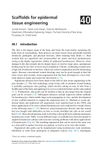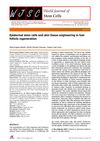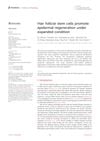Search
forLearn
4 / 4 resultslearn Osteopontin
signaling protein that, when suppressed, may grow hair by reducing inflammation and stem cell loss
learn Thymosin Beta 4
learn Low Level Laser Therapy
laser therapy for anti-inflammatory and likely insignificant hair regrowth effects
Research
5 / 1000+ resultsresearch Progress in Studies of Epidermal Stem Cells and Their Application in Skin Tissue Engineering
Epidermal stem cells show promise for skin repair and regeneration.

research Scaffolds for Epidermal Tissue Engineering
New scaffold materials help heal severe skin wounds and improve skin regeneration.

research Epidermal Stem Cells and Skin Tissue Engineering in Hair Follicle Regeneration
Hair follicle regeneration needs special conditions and young cells.

research Development, Characterization, and Use of a Fetal Skin Cell Bank for Tissue Engineering in Wound Healing
Fetal skin cells from a cell bank heal wounds faster and with less scarring than adult cells.

research Hair Follicle Stem Cells Promote Epidermal Regeneration Under Expanded Condition
Hair follicle stem cells help skin heal and grow during stretching.
Community Join
5 / 80 resultscommunity New and Interesting HairLoss Studies/Papers/Reviews
Hair loss treatments discussed include Dutasteride with Ketoconazole, tissue engineering strategies, and androgenetic alopecia therapies. Massage doubles follicular retention, improving treatment effectiveness.
community The end of balding: We may have just found the secret to hair regrowth
MCL-1 is important for hair follicle stem cell survival, but its impact on human hair regrowth is unclear. Minoxidil and finasteride are the main treatments, with doubts about new discoveries leading to effective human solutions soon.
community So we have 20k dollars human like machines available but no new effective treatment for hairloss since finasteride :)
There have been no new effective hair loss treatments since finasteride, despite technological advancements. Current treatments include finasteride, minoxidil, and RU58841, with ongoing challenges and potential future solutions in research.
community Story time! The Great Unbalding (PP405)
PP405 is a promising new hair loss treatment that may reactivate dormant hair follicles without side effects. It could surpass traditional treatments like minoxidil and finasteride if successful in further trials.
community (0.5 mg Dutasteride and 5 mg oral Minoxidil/day) 32 years old - Follow up on last post
The user experienced significant hair regrowth using 0.5 mg Dutasteride and 5 mg oral Minoxidil daily, after initially using finasteride and a lower dose of Minoxidil. They are considering dermarolling or derma stamping to improve results further before opting for a hair transplant.